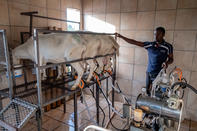Many farmers avoid the task of recordkeeping as it can be time-consuming. However, it is a crucial task for becoming a better farmer. Banks, government agencies and other funders demand good farm recordkeeping before money or loans will be made available.

In addition, good recordkeeping in farming will help a farmer to plan better and make more accurate forecasts. Recordkeeping of rainfall and weather patterns can even help farmers to predict the weather for the next planting season. Having records of expenses and income can help with financial planning.
Keeping a record on germination rates of the seeds bought this season can help the farmer to select better seeds for next season. In the case of livestock, there should be recordkeeping of bloodlines, pest and diseases, feed types and consumption.
This may help to prevent inbreeding, better manage pests and diseases and provide the best feed for improved growth.
What are Farm Records?
Farm records usually consist of documents such as physical inventory, depreciation, receipts and bills, labour records, details of machinery, physical production records and so on.How to Start Recordkeeping?
Recordkeeping on a farm should include an inventory, valuation of assets (and its depreciation) and a record of accounts. An asset is anything of value that can be converted into cash.
Inventory Make a list of all the physical assets on the farm and their values in Rand. Examples of assets are land, buildings, machinery on the farm, harvested crops, crops on the field and livestock.
Asset valuation The second step in recordkeeping is asset valuation - expressed in Rands. The method used for asset valuation depends on the asset’s nature and purpose, but be sure to use the same valuation method every year.
Record of Accounts All the income and expenditure of the farm should be recorded.
Asset Valuation Methods
Asset valuation methods that are generally used:
value The asset is valued at the current market price. Used to value stock and crops.
Cost This method uses the asset’s original purchase cost and works best for supplies such as fuel and feed that have been recently bought and still have purchase prices available. Assets that lose value over time such as farm implements are valuated differently.
Lower cost or market price This method values an item at both its original prices and market value. The lowest value is chosen.
Farm production cost This method is used on crops that are planted but not yet harvested.
Cost, minus depreciation This method is used for items that are used in the production process, but lose value over time such as machinery. Its value is reduced by the amount of depreciation for that year.
What is Depreciation?
Recordkeeping in farming should keep track of the depreciation of assets. Depreciation refers to the reduction in the value of assets such as vehicles, machinery, implements, equipment and tools.
This loss in value is due to age, wear and tear and obsolescence (being useless). Depreciation is not a physical cash cost but instead the decrease in value of an asset that is written off over the expected lifetime of the asset.
Records of Accounts
For proper financial recordkeeping on a farm, it is crucial to keep track of all income and expenditure on the farm. Keep individual records to record income and expenditure of every individual enterprise on the farm. For example, keep separate records for maize and potatoes.
A recordkeeping system is needed to calculate the net farm income and taxable income for a financial year, to analyse the cash flow, to create budgets for the future and to keep track of each product to ensure it is produced cost-effectively. The sources from which the record accounts can be obtained include: Bank statements. Cash analysis book - include receipts and payments here.
Petty cash book - only cash transactions are recorded in this book. Wage book - indicates wages paid, debts and repayments. Deposit book - all cash receipts should be recorded here. Proof of payment, credit vouchers and sales slips, statements, invoices and delivery slips.
Financial Statements and Recordkeeping
The farm records are used to draw up financial statements. Financial statements include the balance sheet, income statement and cash flow statement.
The balance sheet shows what the farm owes and what the farms owns and gives an overview of the farm’s financial position at a given time. The income statement shows the expenses and income from one balance sheet to the next. The cash flow statement shows the flow of cash into the farm and out of the farm.
Source Water Research Commission